Portable Device for Potentiometric Determination of Antioxidant Capacity
Abstract
1. Introduction
2. Materials and Methods
2.1. Chemicals
2.2. Materials
2.3. Equipment
2.4. Methods and Calculations
2.5. Microcell Design and Fabrication
2.6. Reagents’ Immobilization on CSPEs
2.7. Microcells’ Testing
2.8. AOC Determination Using Microcells
2.8.1. AOC Determination with a Ready-Made Solution of Reagents
2.8.2. AOC Determination with Immobilized Reagents
2.9. Statistical Analysis
3. Results and Discussion
3.1. Selection of Working Conditions of the Analysis
3.1.1. Electrode Material
3.1.2. Selection of Reagents’ Solution Composition for Immobilization on CSPEs
- The reagents’ solution obtained after the dissolution of the precipitate must provide physiological conditions for the analysis. Since antioxidants can contain H+ ions and change the pH of the medium during analysis, so the use of a buffer solution is necessary. In addition, the acidity of the medium affects the potential of the working electrode. Therefore, to obtain stable results, it is necessary to create a buffer medium that would prevent the potential shift that is not caused by the reaction of an antioxidant with a model oxidant. At рН = 7.4, the reaction rate between the antioxidant and К3[Fe(CN)6] is rather high [63], and the capacity of the K-Na-phosphate-buffered solution (PBS) is sufficient to compensate for the pH shift when a sample is added to the cell [64,65].
- The reagent solution must have sufficient electrical conductivity to implement potentiometric measurements.
- The immobilized reagent should be uniform, finely dispersed, and quickly dissolve in a small volume of water and the analyzed solution.
- Buffer solution:
- Background electrolyte:
3.1.3. Selection of a Method and Conditions for Reagents’ Immobilization on CSPEs
3.2. Analytical Characterization
3.3. Sample Analysis
4. Conclusions
5. Patents
Supplementary Materials
Author Contributions
Funding
Institutional Review Board Statement
Informed Consent Statement
Data Availability Statement
Acknowledgments
Conflicts of Interest
References
- Zenkov, N.K.; Lankin, V.Z.; Menshchikov, E.B. Oxidative Stress: Biochemical and Pathophysiological Aspects; MAIK, Nauka/Interperiodika: Moscow, Russia, 2001; 343p. (In Russian) [Google Scholar]
- Vladimirov, Y.A.; Azizova, O.A.; Deev, A.I. Free radicals in living systems. Itogi Nauk. I Tekhniki. Ser. Biophys. 1991, 29, 1–249. [Google Scholar]
- Richards, D.M.C.; Dean, R.T.; Jessup, W. Membrane proteins are critical targets in free radical mediated cytolysis. Biochim. Biophys. Acta 1988, 946, 281–288. [Google Scholar] [CrossRef] [PubMed]
- Drapier, J.C.; Hibbs, J.B. Differentiation of murine macrophages to express nonspecific cytotoxicity for tumor cells results in L-arginine-dependent inhibition of mitochondrial iron-sulfur enzymes in the macrophage effector cells. J. Immunol. 1988, 140, 2829–2838. [Google Scholar] [CrossRef]
- Hoffmann, M.E.; Mello-Filho, A.C.; Meneghini, R. Correlation between cytotoxic effect of hydrogen peroxide and the yield of DNA strand breaks in cells of different species. Biochim. Biophys. Acta 1984, 781, 234–238. [Google Scholar] [CrossRef] [PubMed]
- Durackowa, Z. Some current sights into oxidative stress. Physiol. Res. 2010, 59, 459–469. [Google Scholar] [CrossRef]
- Abuja, P.M.; Albertini, R. Methods for monitoring oxidative stress, lipid peroxidation and oxidation resistance of lipoproteins. Clin. Chim. Acta 2001, 306, 1–17. [Google Scholar]
- Rodrigo, R. Oxidative Stress and Antioxidants: Their Role in Human Diseases; Nova: New York, NY, USA, 2009; pp. 9–10. [Google Scholar]
- Morimoto, M.; Hashimoto, T.; Tsuda, Y.; Kitaoka, T.; Kyotani, S. Evaluation of oxidative stress and antioxidant capacity in healthy children. J. Chin. Med. Assoc. 2019, 82, 651–654. [Google Scholar] [CrossRef]
- Montezano, A.C.; Dulak-Lis, M.; Tsiropoulou, S.; Harvey, A.; Briones, A.M.; Touyz, R.M. Oxidative Stress and Human Hypertension: Vascular Mechanisms, Biomarkers, and Novel Therapies. Can. J. Cardiol. 2015, 31, 631–641. [Google Scholar] [CrossRef]
- Qian, Y.; Yan, L.; Wei, M.; Song, P.; Wang, L. Seeds of Ginkgo biloba L. inhibit oxidative stress and inflammation induced by cigarette smoke in COPD rats through the Nrf2 pathway. J. Ethnopharmacol. 2023, 301, 115758. [Google Scholar] [CrossRef]
- Kruk, J.; Duchnik, E. Oxidative Stress and Skin Diseases: Possible Role of Physical Activity. Asian Pac. J. Cancer P 2014, 15, 561–568. [Google Scholar] [CrossRef]
- Azmanova, M.; Pitto-Barry, A. Oxidative Stress in Cancer Therapy: Friend or Enemy? ChemBioChem 2022, 23, e202100641. [Google Scholar] [CrossRef] [PubMed]
- Chen, X.; Guo, C.; Kong, J. Oxidative stress in neurodegenerative diseases. Neural Regen. Res. 2012, 7, 376–385. [Google Scholar] [CrossRef] [PubMed]
- Apak, R. Current Issues in Antioxidant Measurement. J. Agric. Food Chem. 2019, 67, 9187–9202. [Google Scholar] [CrossRef] [PubMed]
- Brainina, K.Z.; Alyoshina, L.V.; Gerasimova, E.L.; Kazakov, Y.E.; Beykin, Y.B.; Belyaeva, S.V.; Usatova, T.I.; Inzhevatova, O.V.; Ivanova, A.V.; Khodos, M.Y. New electrochemical methods of determining antioxidant activity of blood and blood fractions. Electroanalysis 2009, 21, 618–624. [Google Scholar] [CrossRef]
- Ivanova, A.V.; Gerasimova, E.L.; Gazizullina, E.R. New antiradical capacity assay with the use potentiometric method. Anal. Chim. Acta 2019, 1046, 69e76. [Google Scholar] [CrossRef]
- Valgimigli, L.; Pedulli, G.F.; Paolini, M. Mesasurement of antioxidative stress by EPR radical-probe technique. Free Radical Bio. Med. 2001, 31, 708–716. [Google Scholar] [CrossRef]
- Ghiselli, A.; Serafini, M.; Maiani, G.; Azzini, E.; Ferro-Luzzi, A. A fluorescence-based method for measuring total plasma antioxidant capability. Free Radical Bio. Med. 1987, 18, 29–36. [Google Scholar] [CrossRef]
- Krasovska, A.; Rosiak, D.; Czkapiak, K.; Lukaszewicz, M. Chemiluminescence detection of peroxyl radicals and comparison of antioxydant activity of phenolic compounds. Curr. Top. Biophys. 2000, 24, 89–95. [Google Scholar]
- Benzie, I.F.; Strain, J.J. The ferric reducing ability of plasma (FRAP) as a measure of “antioxidant power”: The FRAP assay. Anal. Biochem. 1996, 239, 70–76. [Google Scholar] [CrossRef]
- Floyd, R.A.; Henderson, R.; Watson, J.J.; Wong, P.K. Use of salicylate with high pressure liquid chromatography and electrochemical detection (LCE) as a sensitive measure of hydroxyl free radicals in adriamycin treated rats. Free Radic. Biol. Med. 1986, 2, 13–18. [Google Scholar]
- Lodovici, M.; Casalini, C.; Cariaggi, R.; Michelucci, L.; Dolara, P. Levels of 8-hydroxy-2-deoxyguanosine, a marker of oxidative DNA damage, in human leukocytes. Free Radic. Biol. Med. 2000, 28, 13–17. [Google Scholar] [CrossRef]
- Korotkova, E.I.; Karbainov, Y.A.; Avramchik, O.A. Investigation of antioxidant and catalytic properties of some biologically active substances by voltammetry. Anal. Bioanal. Chem. 2003, 375, 465–468. [Google Scholar] [CrossRef]
- Haque, M.A.; Morozova, K.; Ferrentino, G.; Scampicchio, M. Electrochemical Methods to Evaluate the Antioxidant Activity and Capacity of Foods: A Review. Electroanalysis 2021, 33, 1419–1435. [Google Scholar] [CrossRef]
- Dervisevic, E.; Tuck, K.L.; Voelcker, N.H.; Cadarso, V.J. Recent Progress in Lab-On-a-Chip Systems for the Monitoring of Metabolites for Mammalian and Microbial Cell Research. Sensors 2019, 19, 5027. [Google Scholar] [CrossRef] [PubMed]
- Sirivibulkovit, K.; Nouanthavong, S.; Sameenoi, Y. Paper-based DPPH Assay for Antioxidant Activity Analysis. Anal. Sci. 2018, 34, 795–800. [Google Scholar] [CrossRef] [PubMed]
- Piyanan, T.; Athipornchai, A.; Henry, C.S.; Sameenoi, Y. An Instrument-free Detection of Antioxidant Activity Using Paper-based Analytical Devices Coated with Nanoceria. Anal. Sci. 2018, 34, 97–102. [Google Scholar] [CrossRef]
- Fauziyah, N.; Andini; Anneke; Oktavia, I.; Sari, M.I.; Sulistyarti, H.; Sabarudin, A. Developing a Mickey-Mouse-Designed Microfluidic Paper-Based Analytical Device (μPAD) to Determine The Antioxidant Activity of Green Tea. In IOP Conf. Series: Materials Science and Engineering; IOP Publishing: Bristol, UK, 2019; Volume 546, p. 32007. [Google Scholar] [CrossRef]
- Wiedemair, V.; Huck, C.W. Evaluation of the performance of three hand-held near-infrared spectrometer through investigation of total antioxidant capacity in gluten-free grains. Talanta 2018, 189, 233–240. [Google Scholar] [CrossRef]
- Calabria, D.; Guardigli, M.; Severi, P.; Trozzi, I.; Pace, A.; Cinti, S.; Zangheri, M.; Mirasoli, M. A Smartphone-Based Chemosensor to Evaluate Antioxidants in Agri-Food Matrices by In Situ AuNP Formation. Sensors 2021, 21, 5432. [Google Scholar] [CrossRef]
- Fernández-la-Villa, A.; Pozo-Ayuso, D.F.; Castaño-Álvarez, M. Microfluidics and electrochemistry: An emerging tandem for next-generation analytical microsystems. Curr. Opin. Electrochem. 2019, 15, 175–185. [Google Scholar] [CrossRef]
- Ivanova, A.; Gerasimova, E.; Gazizullina, E. Study of Antioxidant Properties of Agents from the Perspective of Their Action Mechanisms. Molecules 2020, 25, 4251. [Google Scholar] [CrossRef]
- Aronbaev, D.; Aronbaev, S.; Vasina, S.; Ergasheva, S.; Raimkulova, C. Portable amperometric sensor for measuring the total antioxidant activity of substances. Int. J. Eng. Sci. Res. Technol. 2021, 10, 13–22. [Google Scholar] [CrossRef]
- Lin, Q.; Hua, X.; Gong, F.; Cai, L.; Liu, J.; Sha, L. Comparison of Electrochemical Sensing Platform and Traditional Methods for the Evaluation of Antioxidant Capacity of Apple Cider. Int. J. Electrochem. Sci. 2022, 17, 220325. [Google Scholar] [CrossRef]
- Han, D.; Ma, W.; Wang, L.; Ni, S.; Zhang, N.; Wang, W.; Dong, X.; Niu, L. Design of two electrode system for detection of antioxidant capacity with photoelectrochemical platform. Biosens. Bioelectron. 2016, 75, 458–464. [Google Scholar] [CrossRef] [PubMed]
- Ni, S.; Han, F.; Wang, W.; Han, D.; Bao, Y.; Han, D.; Wang, H.; Niu, L. Innovations upon antioxidant capacity evaluation for cosmetics: A photoelectrochemical sensor exploitation based on N-doped graphene/TiO2 nanocomposite. Sens. Actuator B-Chem. 2018, 259, 963–971. [Google Scholar] [CrossRef]
- Apak, R.; Gorinstein, S.; Böhm, V.; Schaich, K.M.; Özyürek, M.; Güçlü, K. Methods of measurement and evaluation of natural antioxidant capacity/activity (IUPAC Technical Report). Pure Appl. Chem. 2013, 85, 957–998. [Google Scholar] [CrossRef]
- Kazakov, Y.; Khodos, M.; Vidrevich, M.; Brainina, K. Potentiometry as a Tool for Monitoring of Antioxidant Activity and Oxidative Stress Estimation in Medicine. Crit. Rev. Anal. Chem. 2019, 49, 150–159. [Google Scholar] [CrossRef]
- Brainina, K.Z.; Ivanova, A.V.; Sharafutdinova, E.N.; Lozovskaya, E.L.; Shkarina, E.I. Potentiometry as a method of antioxidant activity investigation. Talanta 2007, 71, 13–18. [Google Scholar] [CrossRef]
- Brainina, K.Z.; Gerasimova, E.L.; Varzakova, D.P.; Balezin, S.L.; Portnov, I.G.; Makutina, V.A.; Tyrchaninova, E.V. Potentiometric Method for Evaluating the Oxidant/Antioxidant Activity of Seminal and Follicular Fluids and Clinical Significance of This Parameter for Human Reproductive Function. Open Chem. Biomed. Methods J. 2012, 5, 1–7. [Google Scholar] [CrossRef][Green Version]
- Brainina, K.Z.; Galperin, L.G.; Gerasimova, E.L.; Khodos, M.Y. Noninvasive Potentiometric Method of Determination of Skin Oxidant/Antioxidant Activity. IEEE Sens. J. 2012, 12, 527–532. [Google Scholar] [CrossRef]
- Ivanova, A.V.; Gerasimova, E.L.; Brainina, K.Z. Potentiometric Study of Antioxidant Activity: Development and Prospects. Crit. Rev. Anal. Chem. 2015, 45, 311–322. [Google Scholar] [CrossRef]
- Brainina, K.Z.; Tarasov, A.V.; Vidrevich, M.B. Silver Chloride/Ferricyanide-Based Quasi-Reference Electrode for Potentiometric Sensing Applications. Chemosensors 2020, 8, 15. [Google Scholar] [CrossRef]
- Brainina, K.Z.; Gerasimova, E.L.; Khodos, M.Y.; Vikulova, E.V.; Chernov, V.I.; Noskova, G.N. Method for Determining the Oxidant/Antioxidant Activity of Substances and a Device for Its Implementation/RF. Patent RU 2,486,499 C1, 27 June 2013. [Google Scholar]
- Ivanova, A.V.; Markina, M.G.; Gerasimova, E.L.; Kirillova, V.I. Method for Determining the Antioxidant Capacity of Substances and a Device for Its Implementation. Application for Invention 2023112943, 19 May 2023. [Google Scholar]
- Ivoilova, A.; Malakhova, N.; Mozharovskaia, P.; Nikiforova, A.; Tumashov, A.; Kozitsina, A.; Ivanova, A.; Rusinov, V. Study of Different Carbonaceous Materials as Modifiers of Screen-Printed Carbon Electrodes for Detection of the Triazid as Potential Antiviral Drug. Electroanalysis 2022, 34, 1745–1755. [Google Scholar] [CrossRef]
- Brainina, K.Z.; Varzakova, D.P.; Gerasimova, E.L. Chronoamperometric method for determining the integral antioxidant activity. J. Anal. Chem. 2012, 67, 1–7. [Google Scholar] [CrossRef]
- Burns, D.T.; Danzer, K.; Townshend, A. Use of the term “recovery” and “apparent recovery” in analytical procedures (IUPAC Recommendations 2002). Pure Appl. Chem. 2002, 74, 2201–2205. [Google Scholar] [CrossRef]
- Brainina, K.Z.; Kositzina, A.N.; Ivanova, A.V. Screen-printed enzyme-free electrochemical sensors for clinical and food analysis (Review). Compr. Anal. Chem. 2007, 49, 643–666. [Google Scholar] [CrossRef]
- Brainina, K.Z.; Zaharov, A.S.; Vidrevich, M.B. Potentiometry for the determination of oxidant activity. Anal. Methods 2016, 8, 5667–5675. [Google Scholar] [CrossRef]
- González-Sánchez, M.I.; Gómez-Monedero, B.; Agrisuelas, J.; Iniesta, J.; Valero, E. Electrochemical performance of activated screen printed carbon electrodes for hydrogen peroxide and phenol derivatives sensing. J. Electroanal. Chem. 2019, 839, 75–82. [Google Scholar] [CrossRef]
- Tudorache, M.; Bala, C. Biosensors based on screen-printing technology, and their applications in environmental and food analysis. Anal. Bioanal. Chem. 2007, 388, 565–578. [Google Scholar] [CrossRef]
- Li, Y.; Zhou, J.; Song, J.; Liang, X.; Zhang, Z.; Men, D.; Wang, D.; Zhang, X.-E. Chemical nature of electrochemical activation of carbon electrodes. Biosens. Bioelectron. 2019, 144, 111534. [Google Scholar] [CrossRef]
- Kubendhiran, S.; Sakthinathan, S.; Chen, S.M.; Lee, C.M.; Lou, B.S.; Sireesha, P.; Su, C.C. Electrochemically activated screen printed carbon electrode decorated with nickel nanoparticles for the detection of glucose in human serum and human urine sample. Int. J. Electrochem. Sci. 2016, 11, 7934–7946. [Google Scholar] [CrossRef]
- Pan, D.; Rong, S.Z.; Zhang, G.T.; Zhang, Y.N.; Zhou, Q.; Liu, F.H.; Li, M.J.; Chang, D.; Pan, H.Z. Amperometric determination of dopamine using activated screen-printed carbon electrodes. Electrochemistry 2015, 83, 725–729. [Google Scholar] [CrossRef]
- Churinsky, C.; Grgicak, C. The effect of repeated activation on screen-printed carbon electrode cards. In the Proceedings of the 225th ECS Meeting, Orlando, FL, USA, 11–15 May 2014; pp. 1–8. [Google Scholar]
- Wang, J.; Pedrero, M.; Sakslund, H.; Hammerich, O.; Pingarrón, J. Electrochemical activation of screen-printed carbon strips. Analyst 1996, 121, 345–350. [Google Scholar] [CrossRef]
- Shi, K.; Shiu, K.K. Determination of uric acid at electrochemically activated glassy carbon electrode. Electroanalysis 2001, 13, 1319–1325. [Google Scholar] [CrossRef]
- Schuring, J.; Schulz, H.D.; Fischer, W.R.; Böttcher, J. Redox: Fundamentals, Processes and Applications; Springer: New York, NY, USA, 1999; 251p. [Google Scholar]
- Chen, P.; Fryling, M.A.; McCreery, R.L. Electron Transfer Kinetics at Modified Carbon Electrode Surfaces: The Role of Specific Surface Sites. Anal. Chem. 1995, 67, 3115–3122. [Google Scholar] [CrossRef]
- Brainina, K.Z.; Tarasov, A.V.; Khamzina, M.E.; Kazakov, Y.; Stozhko, N. Disposable Potentiometric Sensory System for Skin Antioxidant Activity Evaluation. Sensors 2019, 19, 2586. [Google Scholar] [CrossRef]
- Sharafutdinova, E.N. Potentiometry in the Study of the Antioxidant Activity of Objects of Plant Origin. Ph.D. Thesis, Ural State Technical University—Ural Polytechnic Institute, Yekaterinburg, Russia, 2007. (In Russian). [Google Scholar]
- Ivanova, A.V. Potentiometry in the Study of Antioxidant and Antiradical Properties of Substances. Doctor of Science Thesis, Ural Federal University, Yekaterinburg, Russia, 2019. (In Russian). [Google Scholar]
- State Pharmacopoeia XIII OFS.1.4.1.0018.15; Infusions and Decoctions; Ministry of Health of Russian Federation: Moscow, Russia, 2015; Volume 2, p. 1004. (In Russian)
- Kazakov, Y.E.; Tarasov, A.V.; Alyoshina, L.; Brainina, K.Z. Interplay between antioxidant activity, health and disease. Biointerface Res. Appl. Chem. 2020, 10, 4893–4901. [Google Scholar] [CrossRef]
- Fedorov, V.Y. Dispersity and growth kinetics of K2SO4 crystals in drops of an evaporating solution. J. Tech. Phys. 2009, 79, 54–58. [Google Scholar] [CrossRef]
- Fedoseev, V.B.; Fedoseeva, E.N. States of a supersaturated solution in limited-size systems. JETP Lett. 2013, 97, 473. [Google Scholar] [CrossRef]
- Kozyrev, A.V.; Sitnikov, A.G. Evaporation of a spherical droplet in a moderate-pressure gas. Uspekhi Fiz. Nauk. Russ. Acad. Sci. 2001, 171, 765. [Google Scholar] [CrossRef]
- Fedoseev, V.B.; Maksimov, M.V. Solution-crystal-solution oscillatory phase transitions in the KCl-NaCl-H2O system. Lett. JETPh 2015, 101, 424. [Google Scholar] [CrossRef]
- Poylov, V.Z.; Kuzminykh, K.G.; Titkov, S.N.; Aliferova, S.N. Degradation of potassium ferrocyanide used as an anti-caking agent. Proc. Tomsk. Polytech. Univ.-Eng. Georesources 2021, 332, 45–52. [Google Scholar]
- Deegan, R.D.; Bakajin, O.; Dupont, T.F.; Huber, G.; Nagel, S.R.; Witten, T.A. Capillary flow as the cause of ring stains from dried liquid drops. Nature 1997, 389, 827. [Google Scholar] [CrossRef]
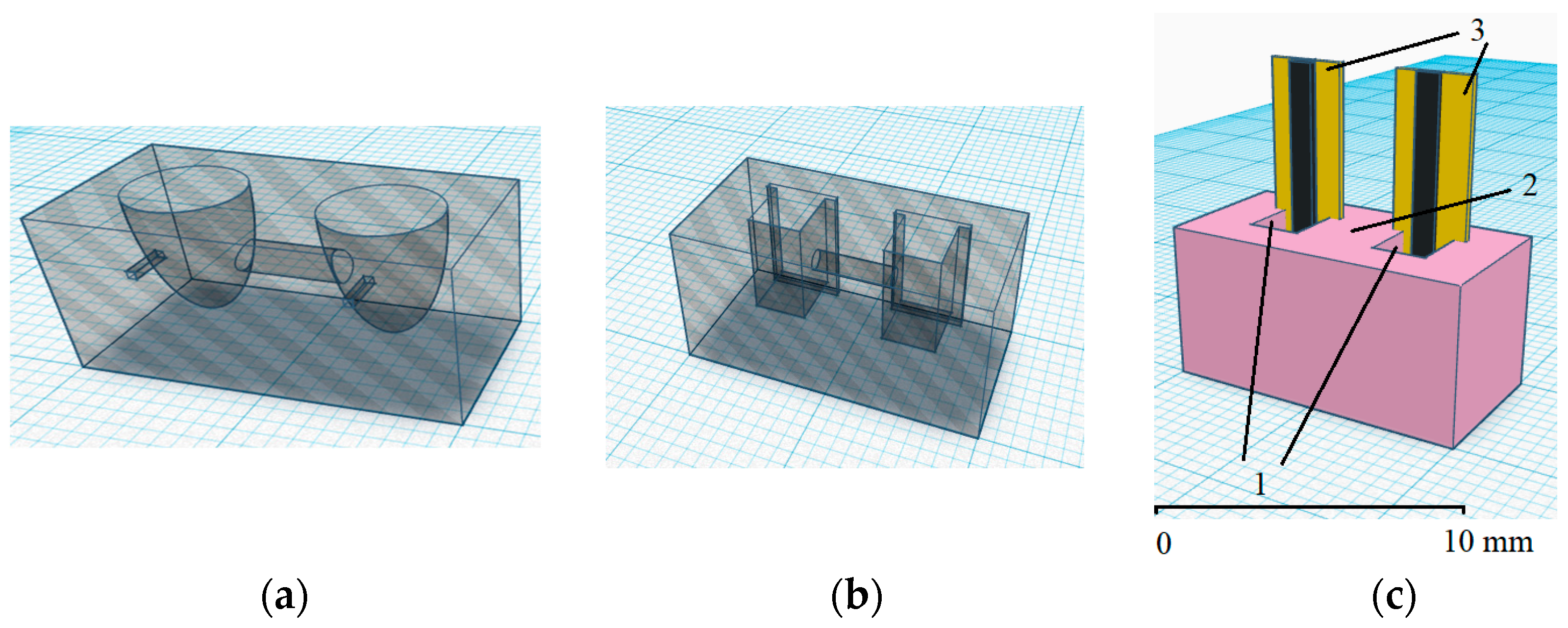
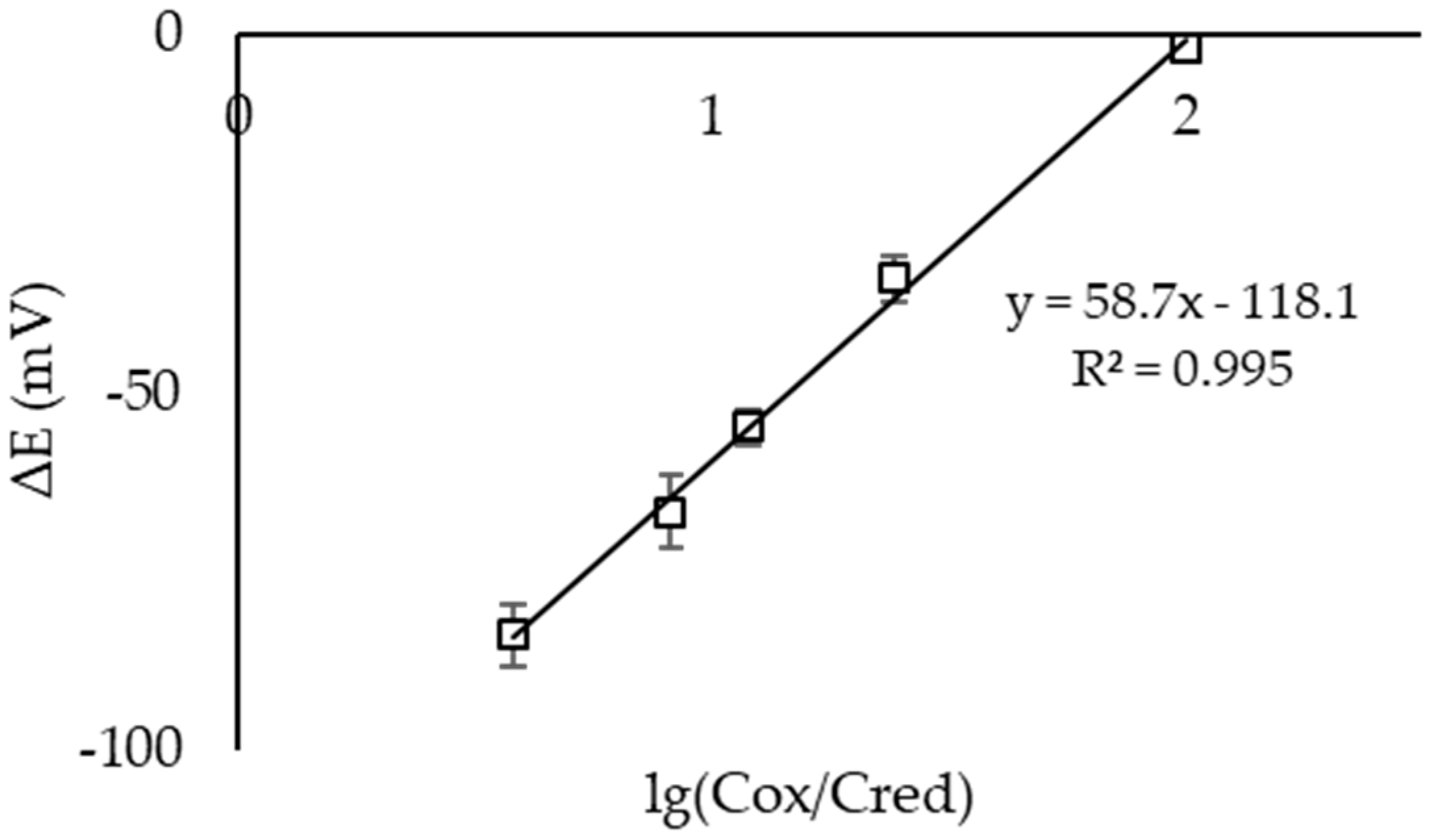

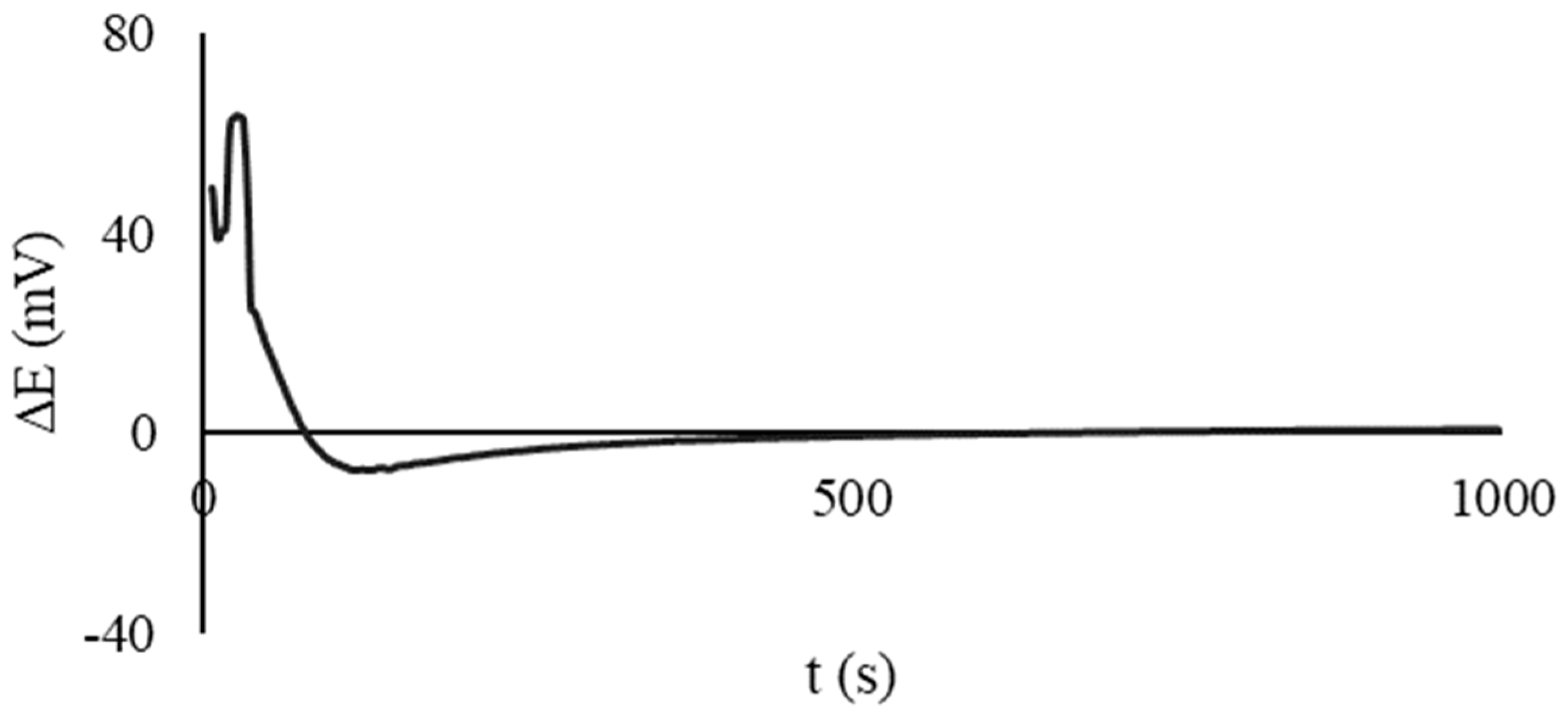


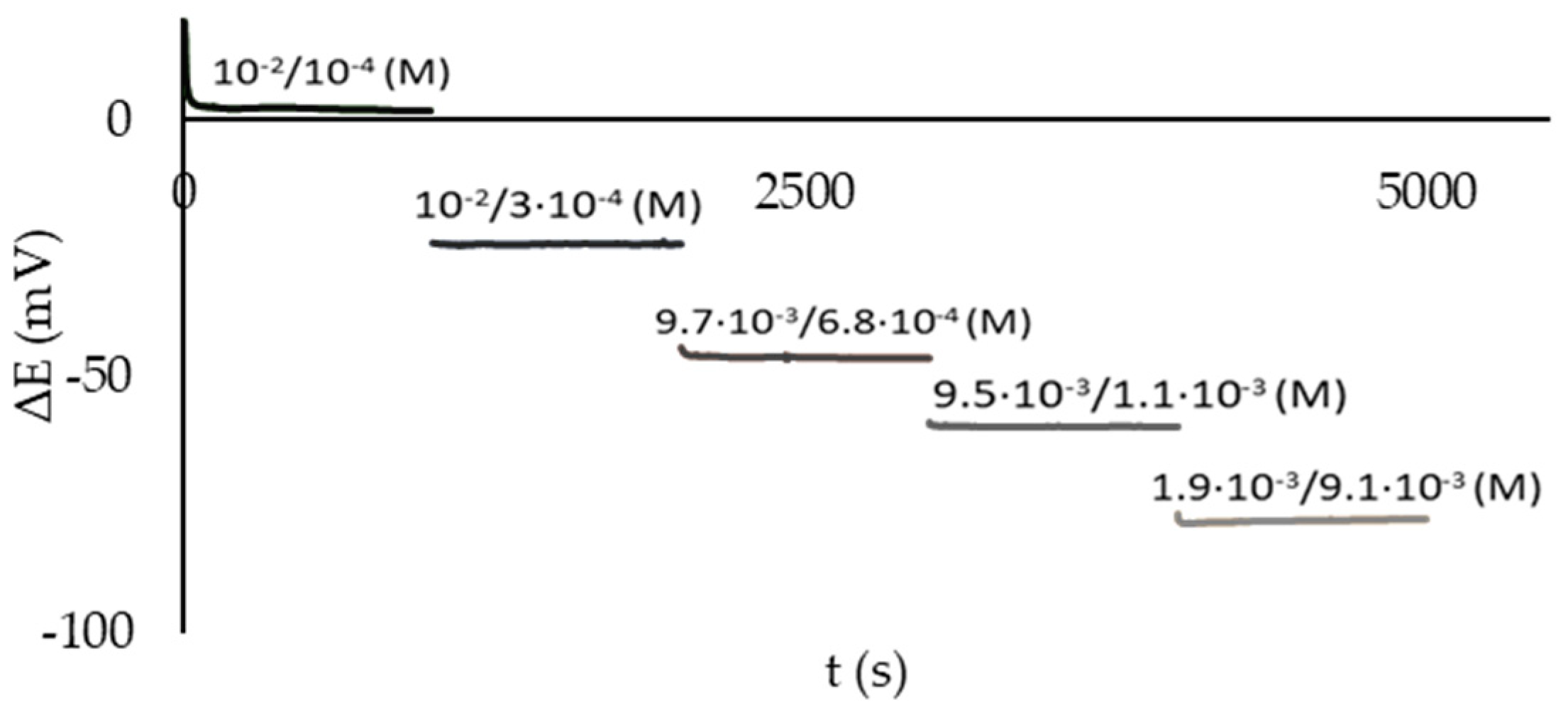
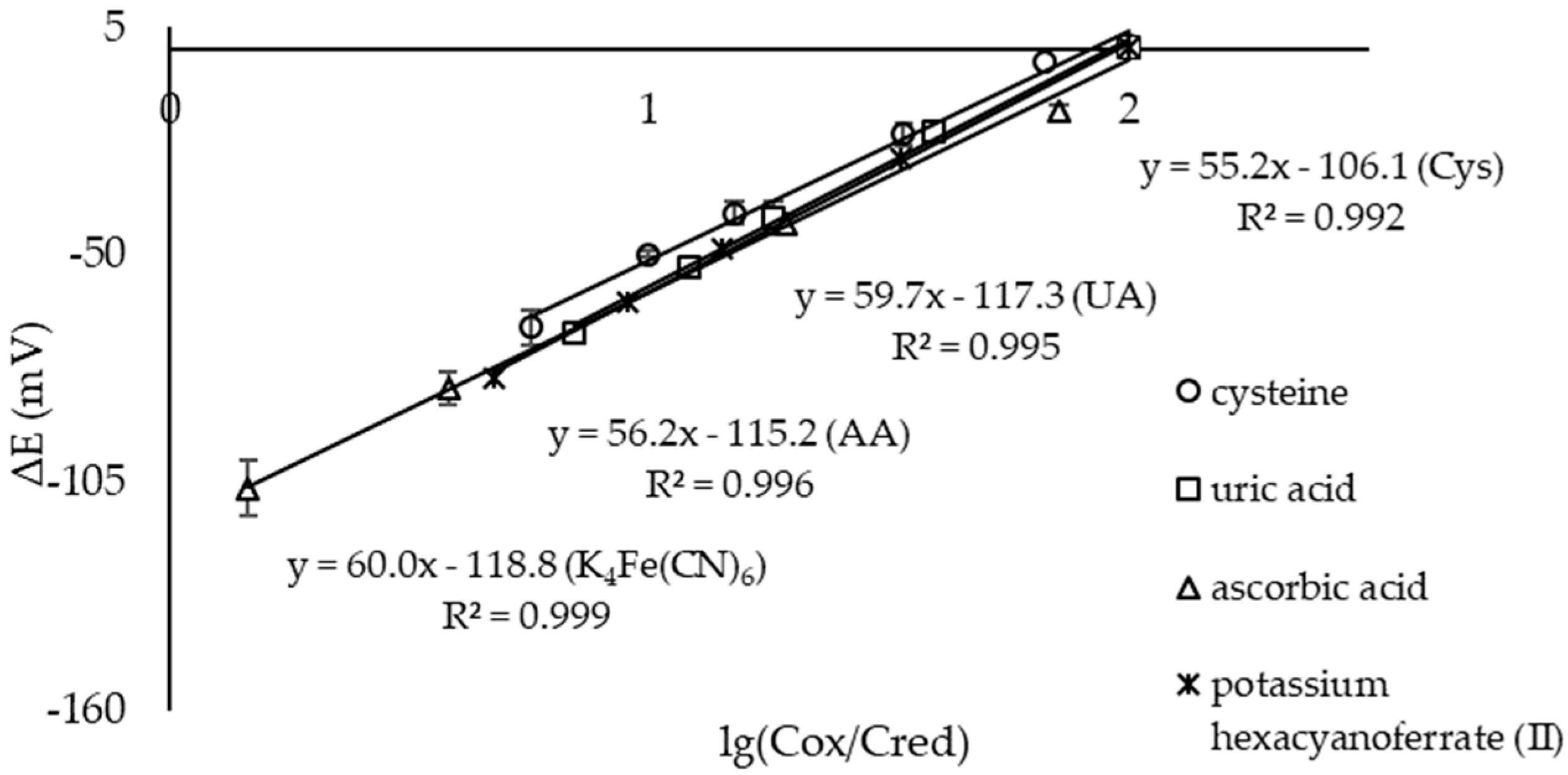
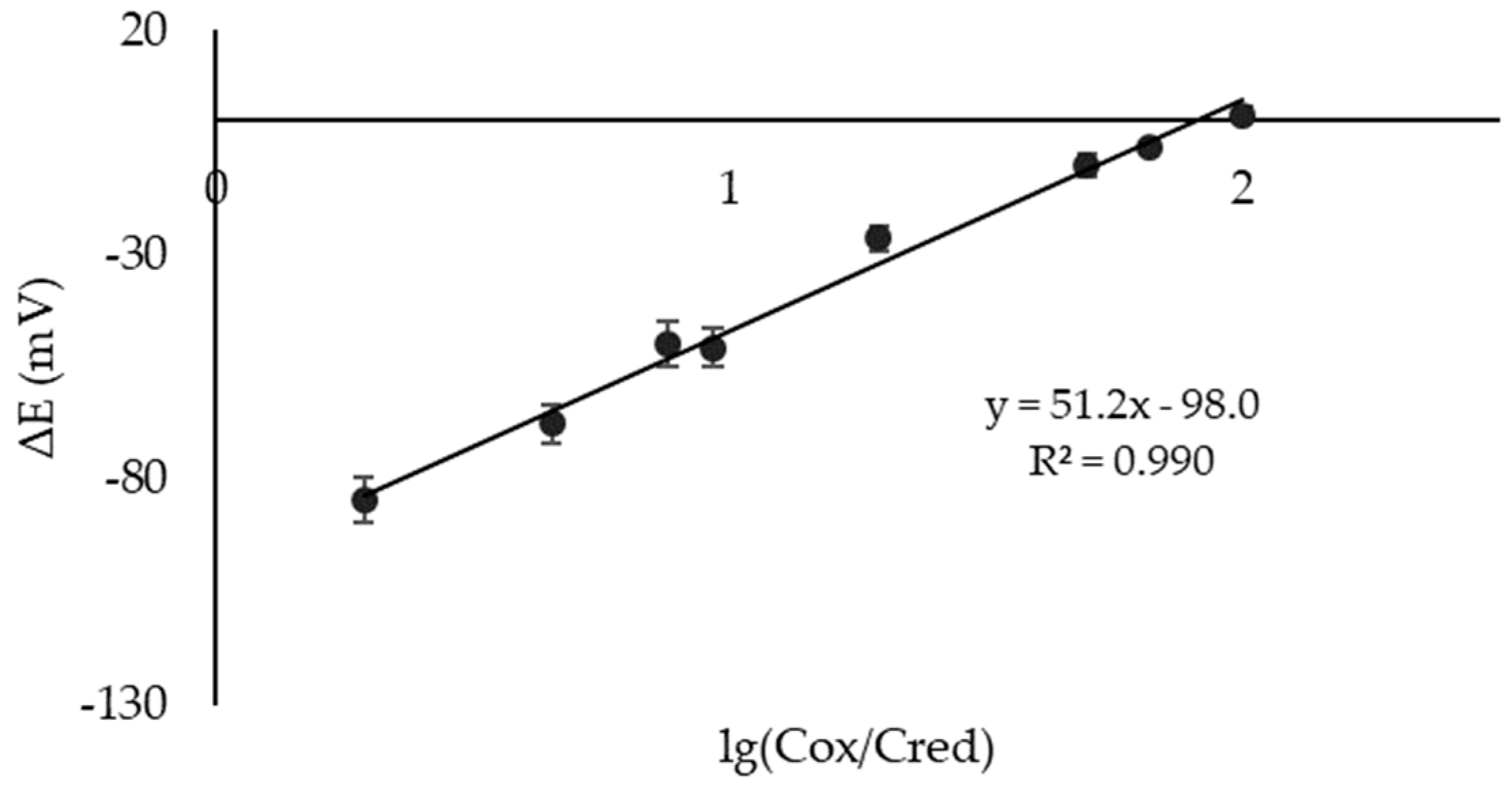
| С(Na2HPO4), M | С(KH2PO4), M | Buffer Capacity PBS (pH 7.4), М | pH PBS after 0.001 М Ascorbic Acid Addition |
|---|---|---|---|
| 0.0006 | 0.0004 | 0.001 | 6.94 |
| 0.0012 | 0.0008 | 0.001 | 7.17 |
| 0.0018 | 0.0012 | 0.002 | 7.25 |
| 0.0024 | 0.0016 | 0.002 | 7.28 |
| 0.0030 | 0.0020 | 0.003 | 7.31 |
| 0.0037 | 0.0023 | 0.003 | 7.32 |
| 0.0043 | 0.0027 | 0.004 | 7.33 |
| 0.0049 | 0.0031 | 0.004 | 7.34 |
| 0.0055 | 0.0035 | 0.005 | 7.35 |
| 0.0061 | 0.0039 | 0.005 | 7.35 |
| С(KCl), M | Linear Regression Equation (E-lg(Cox/Cred) | R2 |
|---|---|---|
| 0.00 | y = (61.9 ± 1.8)x + (189.1 ± 0.2) | 0.9987 |
| 0.02 | y = (58.5 ± 2.0)x + (198.2 ± 1.6) | 0.9998 |
| 0.05 | y = (59.1 ± 1.0)x + (205.6 ± 0.6) | 0.9999 |
| 0.10 | y = (59.3 ± 0.3)x + (214.5 ± 0.8) | 0.9999 |
| 0.20 | y = (59.4 ± 0.4)x + (226.4 ± 0.2) | 0.9999 |
| 0.50 | y = (59.2 ± 1.3)x + (246.3 ± 0.8) | 0.9999 |
| 1.00 | y = (59.5 ± 0.5)x + (263.7 ± 0.3) | 0.9999 |
| Antioxidant | Introduced, ·10−5 mol-eq/L | Found, ·10−5 mol-eq/L | Recovery, % | RSD 1, % |
|---|---|---|---|---|
| ascorbic acid | 4.00 | 3.96 ± 0.24 | 99 | 5 |
| 20.0 | 20.2 ± 1.2 | 101 | 5 | |
| 100 | 93.6 ± 6.0 | 94 | 5 | |
| 200 | 190.0 ± 1.5 | 95 | 7 | |
| uric acid | 73.5 | 62.7 ± 6.2 | 85 | 8 |
| 135 | 118 ± 11 | 88 | 8 | |
| mixes: | ||||
| cysteine:ascorbic acid = 1:1 | 5.50 | 5.70 ± 0.40 | 103 | 5 |
| cysteine:ascorbic acid = 2:1 | 29.1 | 33.3 ± 2.9 | 114 | 8 |
| cysteine:ascorbic acid = 1:3 | 38.5 | 41.9 ± 3.1 | 109 | 7 |
| Antioxidant | Introduced, ·10−4 mol-eq/L | Found, ·10−4 mol-eq/L | Recovery, % | RSD 1, % |
|---|---|---|---|---|
| ascorbic acid | 17.3 | 19.6 ± 3.5 | 113 | 14 |
| 33.3 | 33.5 ± 3.2 | 101 | 11 | |
| gallic acid | 1.6 | 1.5 ± 0.4 | 93 | 15 |
| 3.1 | 2.8 ± 0.8 | 92 | 15 | |
| chlorogenic acid | 1.0 | 1.0 ± 0.2 | 104 | 14 |
| pyrogallol | 3.0 | 3.0 ± 0.2 | 102 | 6 |
| mixes: | ||||
| cysteine:ascorbic acid = 1:1 | 2.2 | 2.0 ± 0.3 | 93 | 6 |
| cysteine:ascorbic acid = 1:3 | 4.4 | 4.2 ± 0.2 | 96 | 2 |
| Object of Analysis | АОC (Microcell), mmol-eq/L | RSD 1, % | АОC (Macrocell), mmol-eq/L | RSD, % | F 2 | t 3 |
|---|---|---|---|---|---|---|
| 1. Berry mix juice (Frutonyanya) | 0.31 ± 0.04 | 5.8 | 0.28 ± 0.02 | 3.8 | 5.3 | 0.01 |
| 2. Rosehip–apple juice (Agusha) | 1.68 ± 0.10 | 2.3 | 1.88 ± 0.06 | 1.4 | 2.3 | 0.04 |
| 3. Apple–cherry juice (Sady Pridonya) | 0.32 ± 0.06 | 7.2 | 0.55 ± 0.07 | 5.7 | 0.8 | 0.05 |
| 4. Apple–grape juice (Dary Kuban) | 0.15 ± 0.02 | 12.5 | 0.12 ± 0.02 | 8.1 | 3.5 | 0.01 |
| 5. Rosehip–apple juice (Dary Kuban) | 2.17 ± 0.15 | 5.6 | 2.56 ± 0.13 | 2.1 | 5.3 | 0.04 |
| 6. Apple juice (Agusha) | 0.19 ± 0.01 | 2.4 | 0.17 ± 0.02 | 3.4 | 0.6 | 0.01 |
Disclaimer/Publisher’s Note: The statements, opinions and data contained in all publications are solely those of the individual author(s) and contributor(s) and not of MDPI and/or the editor(s). MDPI and/or the editor(s) disclaim responsibility for any injury to people or property resulting from any ideas, methods, instructions or products referred to in the content. |
© 2023 by the authors. Licensee MDPI, Basel, Switzerland. This article is an open access article distributed under the terms and conditions of the Creative Commons Attribution (CC BY) license (https://creativecommons.org/licenses/by/4.0/).
Share and Cite
Ivanova, A.V.; Markina, M.G. Portable Device for Potentiometric Determination of Antioxidant Capacity. Sensors 2023, 23, 7845. https://doi.org/10.3390/s23187845
Ivanova AV, Markina MG. Portable Device for Potentiometric Determination of Antioxidant Capacity. Sensors. 2023; 23(18):7845. https://doi.org/10.3390/s23187845
Chicago/Turabian StyleIvanova, Alla V., and Maria G. Markina. 2023. "Portable Device for Potentiometric Determination of Antioxidant Capacity" Sensors 23, no. 18: 7845. https://doi.org/10.3390/s23187845
APA StyleIvanova, A. V., & Markina, M. G. (2023). Portable Device for Potentiometric Determination of Antioxidant Capacity. Sensors, 23(18), 7845. https://doi.org/10.3390/s23187845








